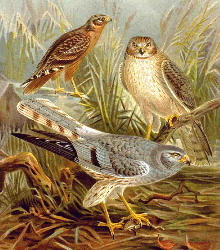 When Iben Hove Sørensen flew to Ghana for her work with Dansk Ornitologisk Forening, a partner of BirdLife International, she couldn’t help but think about the birds. The passerines that she was headed south to study follow a similar course that her plane took to their wintering grounds–over the Mediterranean, sometimes through cloud-choked skies, for thousands of miles. “You can’t see trees, you can’t see water,” she said. “If I was a bird, I’d be so scared.”
When Iben Hove Sørensen flew to Ghana for her work with Dansk Ornitologisk Forening, a partner of BirdLife International, she couldn’t help but think about the birds. The passerines that she was headed south to study follow a similar course that her plane took to their wintering grounds–over the Mediterranean, sometimes through cloud-choked skies, for thousands of miles. “You can’t see trees, you can’t see water,” she said. “If I was a bird, I’d be so scared.”
I met Sørensen in Copenhagen this summer, and she told me a little bit about the work they do. One of the projects that intrigued me was a study looking at farming practices and the Montagu’s harrier. In Denmark, where the harrier is at the northern edge of its breeding range, the population has been decreasing for the past decade; now, there are between 15 and 19 breeding pairs. This year, five of the pairs abandoned their nests for unknown reasons. “That’s the kind of thing we’re worried about,” she said.
When they come north in summer, the birds sometimes find safe haven, or so it seems, in fields. Initially, the organization fenced areas where they found nests to keep foxes out. Later, they realized fencing wasn’t the only thing these birds needed. The high grasses surrounding nest sites allow mice and smaller birds to tunnel in, making more habitat for harrier prey, as well as protecting the nest.
DOF is working with farmers in the southwest corner of Denmark to change growing practices to provide more of this grassy habitat for harriers and what they eat. Farmers get subsidies to sow grasses in a three- to nine-meter-wide swath, and then leave the grasses alone. Earlier studies in Germany and Holland have seen the harrier population increase when field margins like these are used.
The organization is now tracking harriers with satellite transmitters and GPS loggers to learn more about the birds’ travels. Some of the tagged birds are named after the farmers participating in the study. A bird named after Sørensen made the journey to Africa and back before dying in Morocco—the team found the satellite transmitter, and were happy to have another piece in the puzzle of the harrier’s journey, she said.
 I’ve been thinking about the Montagu’s harrier for a while, and then was reminded of them last week when I saw an online paper in Ecology and Evolution about about bowhead whale genetics. By taking DNA samples both from living whales and from toys, vessels, and housing materials from ancient settlements on Somerset Island in the Canadian Arctic, researchers leaned that these whales can and do traverse the ice-choked Arctic Ocean.
I’ve been thinking about the Montagu’s harrier for a while, and then was reminded of them last week when I saw an online paper in Ecology and Evolution about about bowhead whale genetics. By taking DNA samples both from living whales and from toys, vessels, and housing materials from ancient settlements on Somerset Island in the Canadian Arctic, researchers leaned that these whales can and do traverse the ice-choked Arctic Ocean.
Some of these news stories about the paper talked about how the whales’ big, arched heads can crack the ice so that it can breathe. I have trouble not anthropomorphizing in general, but something about migration really brings it out in me. I could imagine myself gasping as I tried to reach the surface, a blinding flash of light as I cracked my head against the ice above. I broke through at last, but that was just one breath, and then there were so many more miles still to swim.
Like Sørensen, that’s how I think of a bird’s migration, too, whether it’s harriers and songbirds traveling to Africa, or the hawks that fly each autumn along California. How tired they must be. How dangerous their flyways. How glad I am to not have to do the same, to not have to be that scared all the time.
But maybe I’m not looking at this right. I do not want to be someone who speaks for how animals look at us, perhaps because I’m terribly embarrassed of what they might report. So say there’s one of us, looking down from afar and away, seeing someone traveling alone on a plane to get that first job, speeding along a highway to see her family, even biking across town to the grocery store. How fragile they are. How amazing that they know the way home, that some of them make it, and that then they do it all over again.
**
Images Top: Lasse Christensen Middle: Johann Friedric Naumann
2 thoughts on “Migrations”
Comments are closed.